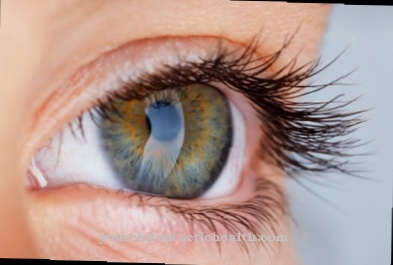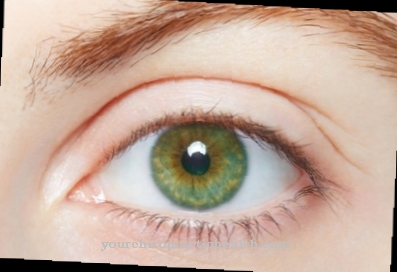The integration is a sub-step of perception processing and gives people a meaningful picture of their environment. Sensory integration encompasses different sensory systems and different sensory qualities. In the case of integration disorders, the integration is disturbed due to a lack of neuronal connection.
What is the integration?

Man perceives the world with his senses. An external stimulus hits special sensory cells that pass the information on to the brain via the spinal cord. What a person recognizes and perceives from all the stimuli of the environment is not decided in the sensory organs, but only with the recognition processes in the brain.
Recognizing a stimulus is one of the last elements in the chain of perception. There are many perceptual sub-steps on the way between sensation and recognition. One of them is sensory integration. This medical term refers to the interplay of different sensory systems and sensory qualities. Only through this coordinated integration is the human being able to recognize and interpret percepts as a situation. For example, the sensory integration of vestibular stimuli and stimuli of depth sensitivity provides information about one's own position in space and influences balance.
The field of proprioception is particularly dependent on sensory integration, but the integrative sub-step of perception applies to different degrees to all sensory systems. The aim of every sensory integration is the appropriate examination of the environment, which is made possible by orderly processing paths of the individual sensory systems. Without sensory integration, humans cannot take targeted or planned actions in response to environmental stimuli. The integration of individual sensory perceptions creates the picture of a situation and thus the possibility of situational reaction.
Function & task
The integration creates an order of all momentary sensory impressions and thus corresponds to the utilization of stimuli as a situational overall picture. Thanks to proprioception, the human brain, for example, receives permanent information about its own body condition and its own posture or movement. This interoceptive perception is integrated by the brain with the exteroceptive perception of stimuli from the environment, for example with those of the visual or hearing sense.
Exteroception constantly informs people about the circumstances of their environment. Only through sensory integration does the brain establish relationships between the stimuli and thus relate, for example, exteroceptive and interoceptive information. An example of this is the perception of gravity, which is integrated with the movements of one's own body and thus brought into relation to the ground.
In this way, humans can react adequately to their environment and the stimuli from their body. The stimuli flow to the brain as sensations in an optimally organized way, so that the person can form overall perceptions from the individual sensations. He can adapt his behavior to these overall perceptions.
Only people with orderly perception can move appropriately in their surroundings, successfully process all stimuli or adequately coordinate the strength and extent of their movements. The ability to integrate influences, for example, body awareness.
Integration requires and at the same time requires an appropriate ability to concentrate and act. Thanks to the integration, a gravitational stimulus on the vestibular system of the inner ear results, for example, in providing proprioceptive muscle activities. In a similar way, thanks to the integration, balance stimuli stimulate various receptors in the semicircular canals of the human ear and thus result in a posture adjustment that prevents people from falling.
Sensory integration is also an important process in connection with the sense of sight and touch. When writing, the sense of sight controls the hand thanks to integration, for example, by integrating its perceptions with the tactile contact stimuli of the skin receptors and the proprioceptive, deeply sensitive stimuli of the joint, muscle and tendon receptors.
You can find your medication here
➔ Medicines against memory disorders and forgetfulnessIllnesses & ailments
A disrupted interplay of individual sensory modalities is known as a sensory integration disorder. If, for example, vestibular stimuli do not trigger postural adjustment, integration in the vestibular system is disturbed. Those affected by this disorder often suffer from low basic muscle tension, so that conscious effort is required to maintain posture stability. Since they have to pay conscious attention to the act, they lack this attention for other actions.
Patients with sensory integration disorders sometimes appear as if they have an attention deficit disorder. However, unlike attention deficit disorder, the reason for their restlessness is not a general attention deficit. Instead, the restlessness is caused by the hypotonicity of the muscles, which completely absorbs the attention and concentration of those affected.
Other integration disorders manifest themselves in tactile or proprioceptive hypersensitivities, which can result in inadequate movement planning and which are often noticeable as clumsiness.
Tactile and vestibular hypersensitivities, which are usually the result of insufficient stimulus modulation by the central nervous system, are also possible. Those affected often show a tactile defense against touch.
All sensory integration disorders are brain physiological dysfunctions that are caused by the inadequate connection of neurons or brain structures. Sometimes they exist from birth, sometimes the integration develops only poorly due to insufficient physical movement - especially in childhood. This is another reason why physical play is extremely important.
Sometimes neurological diseases such as multiple sclerosis or strokes also disrupt the sensory-integrative function in the chain of perception. Such integration disorders due to morphological brain changes are not called sensory integration disorders in technical terminology.
Existing integration disorders can be weakened, if not completely eliminated, by means of sensory integration therapy. A far poorer prognosis applies to incorrect integration after morphological brain changes in the context of neurological diseases. The disturbed integration is often irreversible after the destruction of brain tissue and nerve tissue.



























